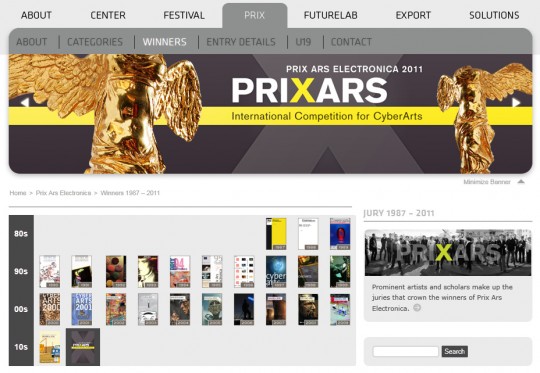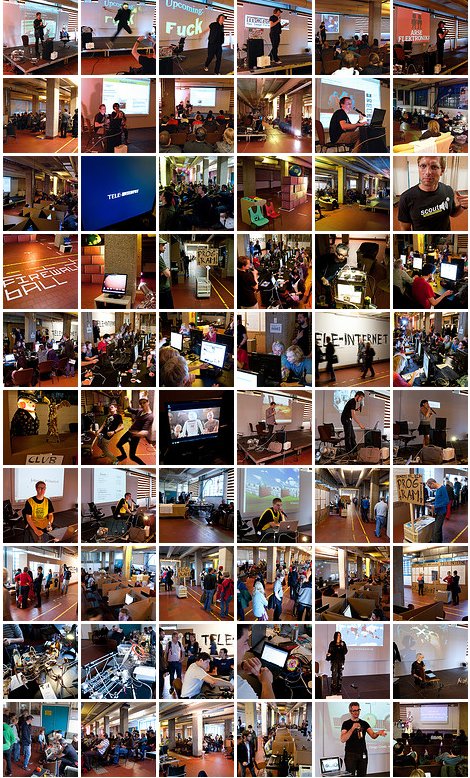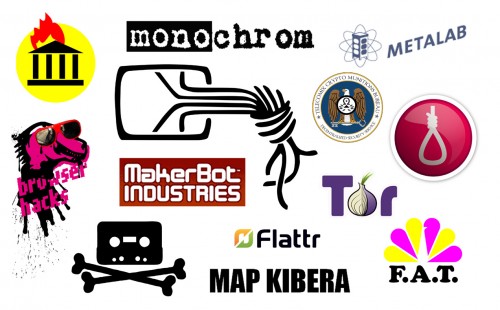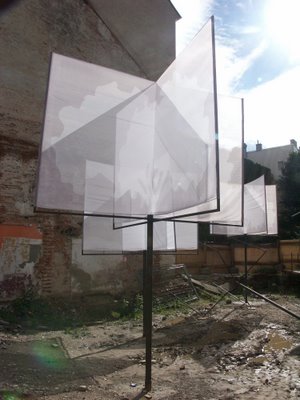Dead Drops: Honorary Mention – Prix Ars Electronica

I am very pleased to announce that Dead Drops won an Honorary Mention at Prix Ars Electronica 2011!
The World in My Hand explores the smartphone as both object and aesthetic inspiration for artistic creation. It comments on public debates surrounding the many uses of smartphones: from always-on media consumption to digital detox, from swiping and matching to ghosting and blocking, from language atrophy to information overload, from resource depletion to status symbol.
The curators, Dr Jörg Garbrecht and Katharina Wenkler, have chosen a narrative approach to the exhibition. In eight chapters, they summarize various aspects and debates surrounding the smartphone, ranging from the launch date of our daily digital companion to its characteristic touchscreen and the contractions of time and space it enables. Deeply personal moments – such as Ai Weiwei’s selfie at the moment of his arrest or Sergey Melnitchenko’s photograph of his son during a blackout in Kyiv – appear alongside themes of perception and presentation of the self, as realized in the glass sculpture Stability by Julija Pociūtė. Other subjects include: looking for love online, as in Ariane Forkel’s Casanova’s Kabinett or John Yuyi’s Tinder Match; the complexities and pitfalls of digital communication, for example in the works of James Akers or Alejandra Seeber; and the smartphone as a means of staying in touch during pandemic lockdown isolation, for instance in the work of George McLeod. Edward Burtynsky’s photograph of lithium mines in the Atacama Desert calls attention to the topic of raw materials for electronic devices.
With works by:
Tornike Abuladze, James Akers, Ai Weiwei, Kate Baker, Aram Bartholl, Tillie Burden, Edward Burtynsky, Yvon Chabrowski, Julia Chamberlain, Rachel Daeng Ngalle, Erwin Eisch, Ariane Forkel, Shige Fujishiro, Valentin Goppel, David Horvitz, Artem Humilevskyi, Gudrun Kemsa, Zsuzsanna Kóródi, Brigitte Kowanz, George McLeod, Sergey Melnitchenko, Jonas Noël Niedermann, Julian Opie, Cornelia Parker, Katie Paterson mit Zeller & Moye, Julija Pociūtė, Rebecca Ruchti, Karin Sander, Jeffrey Sarmiento, Alejandra Seeber, JanHein van Stiphout, Jolita Vaitkute, Sascha Weidner, John Yuyi, Jeff Zimmer
14:00 – 16:00
Killyourphone is an open workshop format. Participants are invited to make their own signal blocking phone pouch. In the pouch the phone can’t send or receive any signals. It is dead! This workshop was run for the first time at the Chaos Communication Congress in Hamburg end of 2013.
Monday 25th of March, 7:00 PM at Web Cafe, Eptanisou 40, 113 61 , Kypseli – Athens
with:
!Mediengruppe Bitnik with Selena Savić & Gordan Savičić , Ingrid Hideki, Joanna Bacas, Kyriaki Goni, Maria Mavropoulou, Marina Gioti, Marsunev, Nadja Buttendorf, Theo Triantafyllidis
Curated by Aram Bartholl & Socrates Stamatatos
Speed Show lands in Greece, the country of souvlaki, the sun (yes we can claim that they originated a celestial body), ouzo, feta, an enormous financial debt. Currently, Greece is also trending for all the wrong reasons namely, gentrification, queerphobia, state crimes and more dystopic incidents.
As 2024 unfolds, we find ourselves amidst a whirlwind of confusion, bombarded with a cacophony of online horrors to consume, an attention span further abbreviated by TikTok’s algorithm and the barrage of incoming stitches.
Stitches Incoming serve as a conduit for creators to engage and converse, traversing from one topic to the next. They have evolved into a new social fabric, weaving connections within an ever-shifting digital and physical landscape while also serving as a testament to personal and collective traumas, both past and present.
What unites the participating digital artists? Perhaps everything and nothing simultaneously… Departing from the traditional Speed Show setup, where artworks are carefully stacked inside internet cafe computers, and drawing inspiration from the structure of TikTok stitches, each piece seems to propel the conversation forward, or perhaps uses the next as a springboard for its own narrative.
Stitch this and stitch that, we have everything you ever wanted (maybe) ! Are we stuck in an infinite loop of sh*tposting, valuable content, the highlight of social issues, personal and interpersonal experiences?
Maybe! Come and find out…
More info on Speed Shows at https://speedshow.net/stitch-incoming/
14:00 – 16:00
Killyourphone is an open workshop format. Participants are invited to make their own signal blocking phone pouch. In the pouch the phone can’t send or receive any signals. It is dead! This workshop was run for the first time at the Chaos Communication Congress in Hamburg end of 2013.
14:00 – 16:00
Killyourphone is an open workshop format. Participants are invited to make their own signal blocking phone pouch. In the pouch the phone can’t send or receive any signals. It is dead! This workshop was run for the first time at the Chaos Communication Congress in Hamburg end of 2013.

I am very pleased to announce that Dead Drops won an Honorary Mention at Prix Ars Electronica 2011!
TELE-INTERNET from Aram Bartholl on Vimeo.
more documentation on http://datenform.de/teleinternet/documentation/
bit.ly/teleinternet
#TELEINTERNET bit.ly/teleinternet at Ars Electronica last weekend was awesome! Thanks to everyone for participating and thx to the As team for support! Most popular ‘piece’ in the show was our coinopperated coffee machine 🙂
Stay tuned for more documentation …



“A new cultural economy” was the title of the symposium curated by Joichi Ito at Ars Electronica a week ago. I enjoyed a lot the brillant speakers most of them from the US and Jonah did write a good abstract on the presentations for Rhizome.
Buzz word collection: Intellectual property, copyright, creative commons, sience commons, GPL, open source, closed, amateur, creativity, remixing, sharing, crowd sourcing/computing, citizen journalism, lost authority, chaos, noise, truth, fear ….. and again and again the big examples: Music, Film and Wikipedia.
Sure we are talking about cultural economy and the example of the music economy development in last decade or the success of Wikipedia shows very well what’s going on. But in retrospective I ‘ve been missing some crucial questions:
– How will/can this whole development affect economy in general?
– What is the role of DIY (Do it yourself) and the free instructions culture development?
– In wich way will physical objcts/products be involved? (Just think of the upcoming rapid prototyping era.)
– Are we only talking about cultural/intellectual property?
– Is there a reason to wait for companies to come up with great new products like a green car, alternative energy sources or just day to day life simplicity?
– Where is the DIY mobile medicin prototyping lab kit for the 3rd world? And will medical industry do the same faults like spoiled music people?
Podcasts of all talks
Unfortunately there are no videos, but I can recommend the talk of Yochai Benkler.
Picture:
Watering cans on a graveyard in Berlin. Instead of having a few public cans everybody has its own one looked to a stand. A very good symbol on a current mindset of property in society. (with a maybe typical german twist.)

The Image Fulgurator by Julius von Bismarck (winner of a Golden Nica) was of course my favorite piece at Ars Electronica. In addition to the groundbreaking idea he did a really good job in documenting his latest interventions for the Cyberarts show at Ars Electronica. Besides a crucifix he added to Obamas speakers desk during the Berlin speech he traveled to Beijing and manipulated the most symbolic place of official China. He projected a pigeon related to the Magritte’s painting “L’Homme au Chapeau Melon” on top of Mao’s face which was then only visible to chinese tourists with digi cams. Wow! A very good way of showing the Image Fulgurator’s power. I hope that he will release that beautiful video documentation online.

A very simple, again paper based and fun interactive project by Richard The » Gunnar Green » Frédéric Eyl » Willy Sengewald got an honary mention and was exhibited at Ars Electronica this year. It reminded me of a picture of an ‘interactive’ facade I posted a while ago.
Appeel is a virus spreading through interacting individuals. Surfaces are covered by thousands of colored stickers laid out in a grid. Peeling a sticker off leaves a white spot in the grid, hence people start individually and collectively changing its appearance. Once off the wall, the stickers ask to be stuck somewhere: people begin putting them on objects, walls, people; they collect them, they compose new images, they write messages. Slowly, the little stickers spread, appearing further away from their source and occupying space.
Prix Ars Electronica 2008, Honorary Mention Interactive Art

Ars Electronica announced golden nica winners for 2008! In the category INTERACTIVE ART Julius von Bismarck got a golden nica for the Image Fulgurator. This piece is just awesome. Congrats Julius! Good job, jury!
The Image Fulgurator is a kind of inverted photo camera physically manipulating other peoples pictures in realtime. The exact moment someone takes a picture the Fulgurator does a flash projection onto the photographed object. A sensor detects other camera flashes and synchronizes the flash projection to them. In case of the movie below tourists end up having weird text messages in their pictures. A Checkpoint Charlie sign has an additional message on it but you can’t see it in real. This is a good picture explaining the setup.
Wow! I really like this piece a lot. Just imagine what you could do with this technology. (That’s why he is going for patent.)

I finally managed to put together a documentation about Second City Ars Electronica 2007. The festival invited me to make a design for Marienstrasse, to show my work and to involve other artists in collaboration for the Second City all relating to metavers and Second Life.
Pics info and more on the project page.
I had a great team! Thx to everybody!

A forest, half virtual, half real, on Marienstraße, Second City, Ars Electronica 2007. As in most computer games and 3D worlds, objects from the real world are “copied” or simulated in simplified form and in accordance with programming constraints. Textures are applied to 3D structures and, depending on lighting conditions, the images making up the virtual scenery are computed in real time during the game. Most trees are constructed out of two interlocking surfaces, each of which is covered with the same tree-view texture. The transparency of the gaps between the leaves and branches is provided by a so-called alpha channel in the graphics file. From a certain distance and the corresponding perspective, this abstracted form of a tree in virtual space doesn’t stand out as a simplification.
…read on & more pics on project page